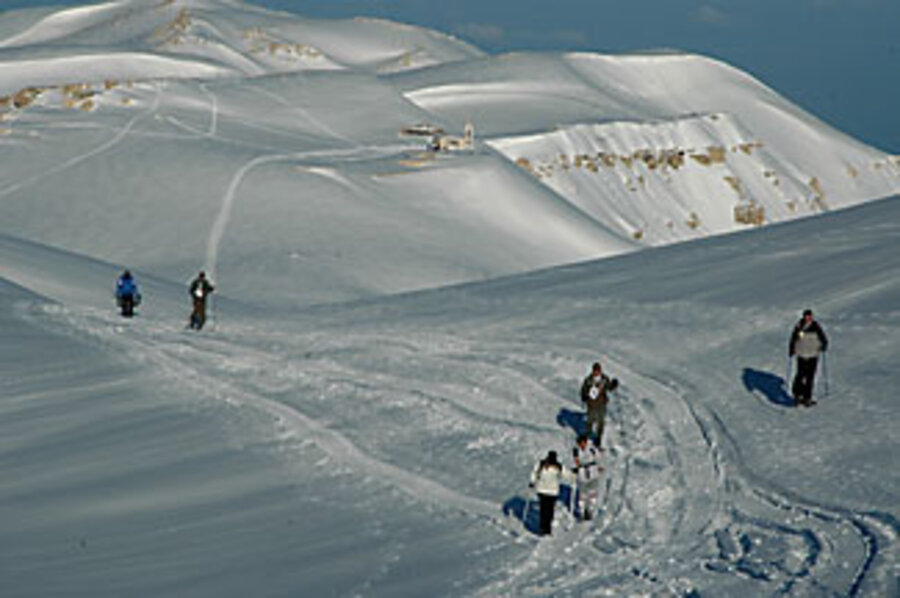An army on snowshoes? It's not in the Alps, but Lebanon.
Loading...
With breath fogging the cold night air, about 300 competitors slid on skis or crunched in snowshoes over frozen ground toward the starting line. A brass band thumped out martial tunes as the race across these snowy mountains was about to begin.
This was no Alpine ski competition, but the first "Raid des Cedres" along a course linking two cedar tree reserves in Lebanon – a nation known more for its hot politics than for its winter sports.
But Lebanon has an enviable terrain of warm Mediterranean coastlines and snow-capped mountains. And the Lebanese Army's Rangers battalion, inspired by the Swiss Army's "Patrouille des Glaciers" ski running race in the Alps, decided it was high time to test their winter skills on mountains at home that boast the Middle East's best ski slopes.
On Saturday, the race participants assembled at The Cedars, a ski resort beside a reserve of Lebanon's oldest cedar trees, and the finishing point for the race. I and my Lebanese and German team members – Youssef Chaitani and Daniel Neuwirth – were among 90 civilians who came to race alongside about 200 soldiers. Hinting at my team's collective lack of fitness, if not our aspirations, we called ourselves "The Cardiac Arrests."
In the afternoon, we were handed our final instructions from Col. Chamel Roukhoz, the ranger's commander. There was to be no sleep for us that night. At 2 a.m. Sunday, an Army bus carried us at breakneck speed along the icy roads to the starting point beside the Tannourine cedar reserve.
"Now I know why the Army included proof of life insurance on the application form," quipped one racer as the bus slewed around another hairpin bend.
On arrival, the teams donned skis and snowshoes and gratefully accepted cups of hot sweet tea.
At an altitude of almost 6,000 feet, the night sky was awash with stars, like a handful of carelessly flung silver flakes. It looked like we would be fortunate with the weather. A week earlier, Youssef and I were forced to abandon a pre-race mountain hike due to blizzard conditions.
The Raid des Cedres consisted of two categories: an 18.6-mile route for the skiers and a 12-mile course for snowshoers. As the race was of military origin, the emphasis was on teamwork rather than individual prowess.
Participants formed teams of three, with members required to pass through checkpoints along the route at the same time. Each team, therefore, was as fast as its slowest member. We were among the snowshoers – and looking at the whip-lean athletes we were up against, we felt doomed.
At 4 a.m. a burst of fireworks lit up the night – and the racers were off. Most wore headlamps to light the way, making us look like an army of glowworms as we climbed up a progressively steep valley.
The freezing tempratures ensured the snow was firm under foot, but the steep slopes and thin air soon had us dripping sweat and gasping for breath. The first hill, the longest of the course with an ascent of almost 1,500 feet, was followed by more strength-sapping hills. Even the steep descents were hard for those with snowshoes. We found it easier to slide down on our rears, tobogan-style, rather than gingerly inch our way down by foot.
A half hour into the race, the sky to the east began to lighten. Snowy mountain tops turned pink as the dawn sun rose into a deep blue sky. Much of the course followed a mountain crest that half encircled The Cedars like a vast natural amphitheater.
Living up to 2,000 years, cedars once covered much of Lebanon's mountains. Highly prized in the ancient world for their scented wood, the cedar forests were steadily felled over the centuries so that only a few patches of the stately trees continue to survive.
At 8,000 feet, the thin air was crystal clear. The cedar reserve at our destination, 2,000 feet below us, was a tiny patch of dark green set against the snow. To the east, the Qadisha Valley, known as the Holy Valley by Lebanon's Maronite Catholics and home to hidden monasteries, cut a deep, ax stroke gash through the limestone landscape.
At 8,800 feet, the highest point on the snowshoe leg of the race, an icy wind howled across the peaks, whipping up knee-high snowdrifts. From here, the snowshoers descended to The Cedars while the skiers continued with their longer route.
By mid morning, most of the teams had arrived, many of us with blistered feet and aching muscles.
Christian Francis, a Lebanese-Austrian and experienced skier who helped the Army delineate the route, was the first skier to finish.
He says the race will become an annual event and hopes that it will earn Lebanon a place on the international ski-running championship circuit.
So how did team "Cardiac Arrests" do? We didn't come last. Let's just leave it at that.





